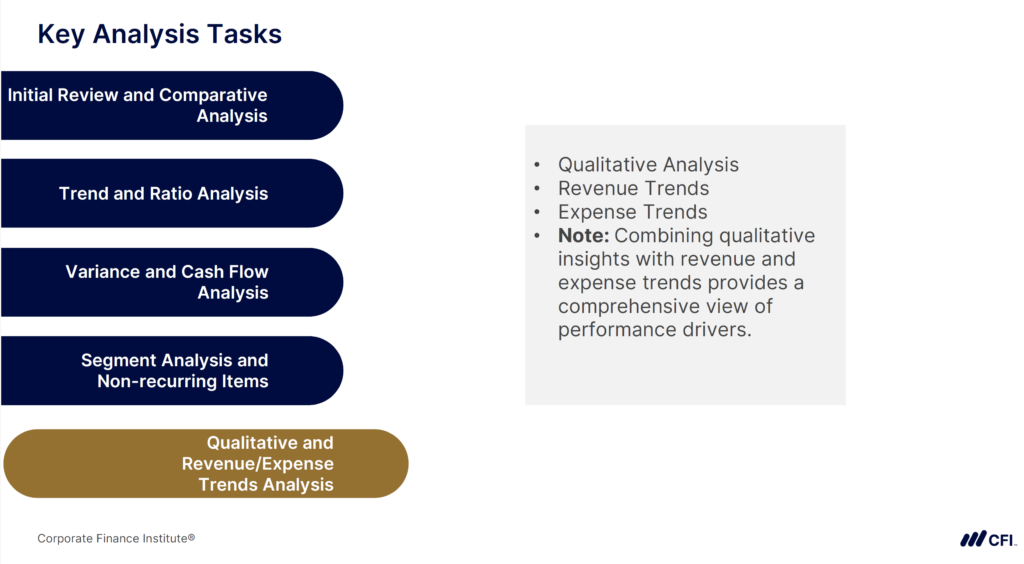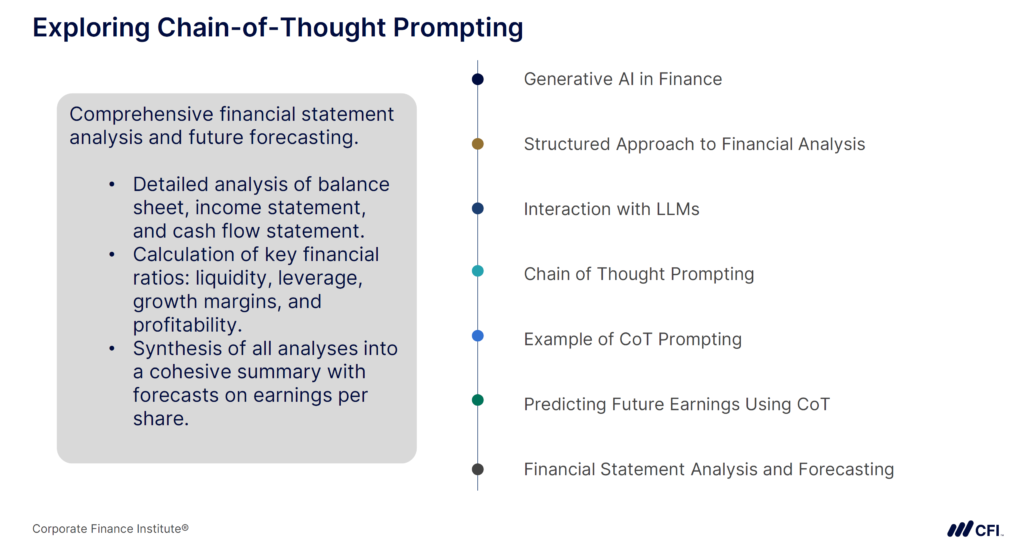- Transform Your Financial Statement Analysis with AI
- Why Should You Use AI for Financial Statement Analysis?
- How AI Changes the Daily Work of Financial Analysts
- Essential AI Tools for Financial Statement Analysis
- Chain-of-Thought Prompting
- Best Practices for AI-Enhanced Analysis
- Looking Ahead: The Future of AI in Financial Statement Analysis
AI and Financial Statement Analysis: Tools and Techniques
Transform Your Financial Statement Analysis with AI
Want to know why leading financial analysts are turning to AI? A recent research study revealed something remarkable: AI tools like ChatGPT can outperform human analysts in predicting future earnings, achieving 60% accuracy compared to analysts’ 53%.
Every quarter brings a tsunami of financial data — earnings reports, SEC filings, management discussions, and market analyses. A single company’s annual report can span hundreds of pages, packed with complex financial information often found buried in footnotes. Even experienced analysts struggle to process it all effectively. That’s where AI transforms financial statement analysis.
Why Should You Use AI for Financial Statement Analysis?
Picture having a skilled assistant who can process years of financial statements in seconds, spot hidden patterns, and help predict future performance. That’s the power of AI in financial statement analysis — it can amplify your expertise, not replace it.
Here’s what makes AI-powered analysis different:
- Processes multiple financial statements simultaneously
- Identifies patterns human analysts might miss
- Generates insights from both quantitative and qualitative data
- Provides consistent, unbiased analysis
- Scales to handle massive amounts of data

How AI Changes the Daily Work of Financial Analysts
The practical effect of AI on financial statement analysis is profound. Instead of spending hours buried in spreadsheets reviewing data and performing calculations, analysts can use AI to do this work for them.
Using AI in their daily work means better outcomes for both analysts and their companies. Analysts can focus on high-value activities like strategic planning and complex decision making. Their work becomes more meaningful and impactful, leading to better financial insights and more informed business decisions.
Essential AI Tools for Financial Statement Analysis
The evolution of AI in financial statement analysis has created powerful tools that work together seamlessly. Let’s explore how these tools transform the way analysts work:
1. ChatGPT: Your Financial Analysis Partner
Open AI’s ChatGPT-4o can work like a financial analyst’s “super assistant,” bringing remarkable capabilities to enhance your workflow. Beyond just crunching numbers, it:
- Reads and processes complex financial statements in seconds
- Calculates key ratios and identifies trends automatically
- Explains findings in clear, actionable language
- Compares performance across multiple periods
- Generates narrative insights from quantitative data
2. Custom GPT Models: Tailored for Financial Analysis
Financial analysts can now create specialized AI models for specific analysis tasks. For the AI study mentioned earlier, Chicago Booth researchers developed a custom GPT “Financial Statement Analyzer” (available through ChatGPT) that:
- Provides detailed company overviews explaining business models and revenue generation
- Summarizes management disclosures and analysis
- Performs comprehensive financial statement analysis
- Calculates and interprets key ratios
- Predicts EPS trends with a specific focus on direction, magnitude, and certainty
The real power comes from training these models with financial expertise. You can provide them with accounting standards, industry benchmarks, and specific analysis requirements. This customization ensures your AI assistant speaks your financial language and follows your analytical approach.
Customized tools represent just the beginning of AI’s potential in financial analysis. By combining the capabilities of tools like ChatGPT with custom-trained models, analysts can create powerful workflows that enhance both efficiency and accuracy.
Chain-of-Thought Prompting
Now that we understand the tools available, let’s explore how to use them effectively. Chain-of-Thought (CoT) prompting is a technique that mirrors how experienced analysts evaluate financial statements. CoT prompting works by breaking complex analysis into manageable steps.
Think of CoT prompting as guiding an extremely capable assistant through your analytical process. Instead of asking for immediate conclusions, you:
- Break down complex questions into logical steps
- Build analysis progressively
- Verify intermediate results
- Reach more reliable conclusions
Practical Application Example
Let’s see how CoT prompting works in practice. Say you’re analyzing a company’s profitability trends. Here’s how you could structure your analysis:
- Initial Review: “Review the income statements for the past three years and identify major revenue and expense trends.”
- Ratio Analysis: “Calculate key profitability ratios including gross margin, operating margin, and net profit margin for each period.”
- Trend Analysis: “Compare these ratios across periods and identify significant changes.”
- Context: “Review management’s discussion and analysis to understand factors driving these changes.”
- Synthesis: “Summarize the key findings and implications for future profitability.”
Financial analysts get more reliable and thorough results by using CoT prompting to guide ChatGPT through a step-by-step process. The technique works particularly well when evaluating a company’s financial health or comparing performance across multiple years.

Best Practices for AI-Enhanced Analysis
While AI tools offer powerful capabilities for financial statement analysis, their effectiveness depends heavily on how you use them. Just as a master chef needs both quality ingredients and proper technique, financial analysts need both good data and the right approach to get the most from AI tools.
As the Chicago Booth study shows, AI can outperform human analysts in some tasks — but only when used properly. AI tools are only as effective as the data and methods that power them, making it essential to adopt best practices at every step of your analysis. The following table outlines key recommendations to help you maximize the value of these powerful tools while ensuring accuracy, security, and long-term success.
AI in Financial Statements Analysis: Best Practices and Practical Tips
The following table highlights some practical tips that can help you work smarter, make sure your work is accurate, and keep your analysis safe and effective.
| ✅ Prepare Your Data | – Convert financial statements to machine-readable formats. – Maintain consistent data structures across periods. – Clean up formatting inconsistencies. – Verify data accuracy before analysis. – Document any data adjustments or assumptions. |
| ✅ Structure Your Analysis | – Begin with clear analytical objectives. – Break complex analyses into logical steps. – Create standardized analysis frameworks. – Document your analytical process. – Build reusable analysis templates. |
| ✅ Validate Results | – Cross-check key calculations manually. – Compare findings with traditional analysis methods. – Consider industry context and economic conditions. – Review outliers and unexpected results. – Document validation steps and findings. |
| ✅ Maintain Security | – Use secure enterprise AI platforms when handling confidential information. – Follow data privacy regulations and company policies. – Document data handling procedures. – Regularly review security protocols. |
| ✅ Continuous Improvement | – Track analysis accuracy and effectiveness. – Gather feedback from stakeholders. – Update custom models regularly. – Stay current with AI capabilities. – Document lessons learned and best practices. |
Remember: AI in financial statement analysis is a powerful ally, not a magic solution. Success comes from combining these best practices with your financial expertise and judgment. By following these guidelines while maintaining high standards for data quality and validation, you’ll develop more reliable insights and make better-informed financial decisions.
Looking Ahead: The Future of AI in Financial Statement Analysis
Tools like ChatGPT, combined with techniques like Chain-of-Thought prompting, enable deeper insights in less time. But to leverage these tools effectively, you need the right skills and knowledge.
Want to master AI-powered financial analysis? CFI’s Advanced Prompting for Financial Statement Analysis course teaches you:
- Advanced AI prompting techniques
- Custom GPT creation for financial analysis
- Best practices for combining AI with traditional analysis methods
- Real-world applications and case studies
Take your financial analysis skills to the next level.
Enroll in Advanced Prompting for Financial Statement Analysis today!